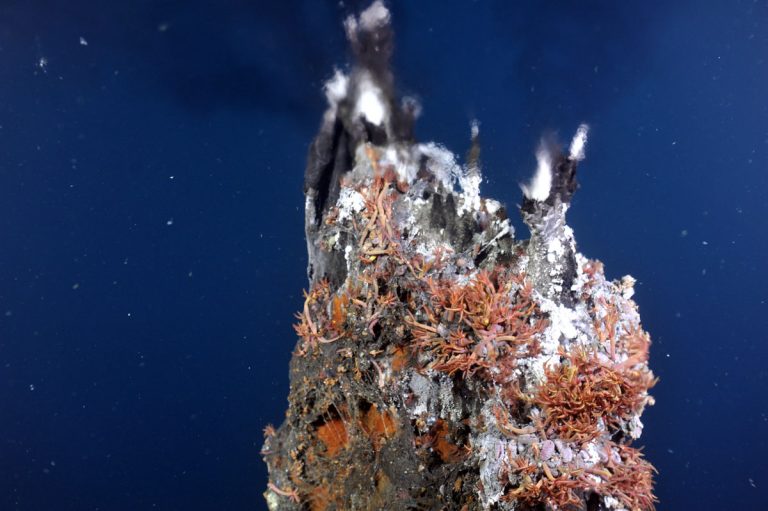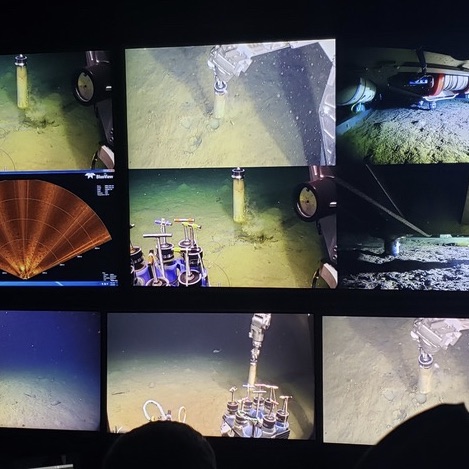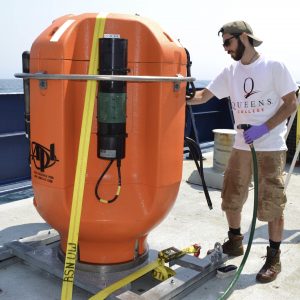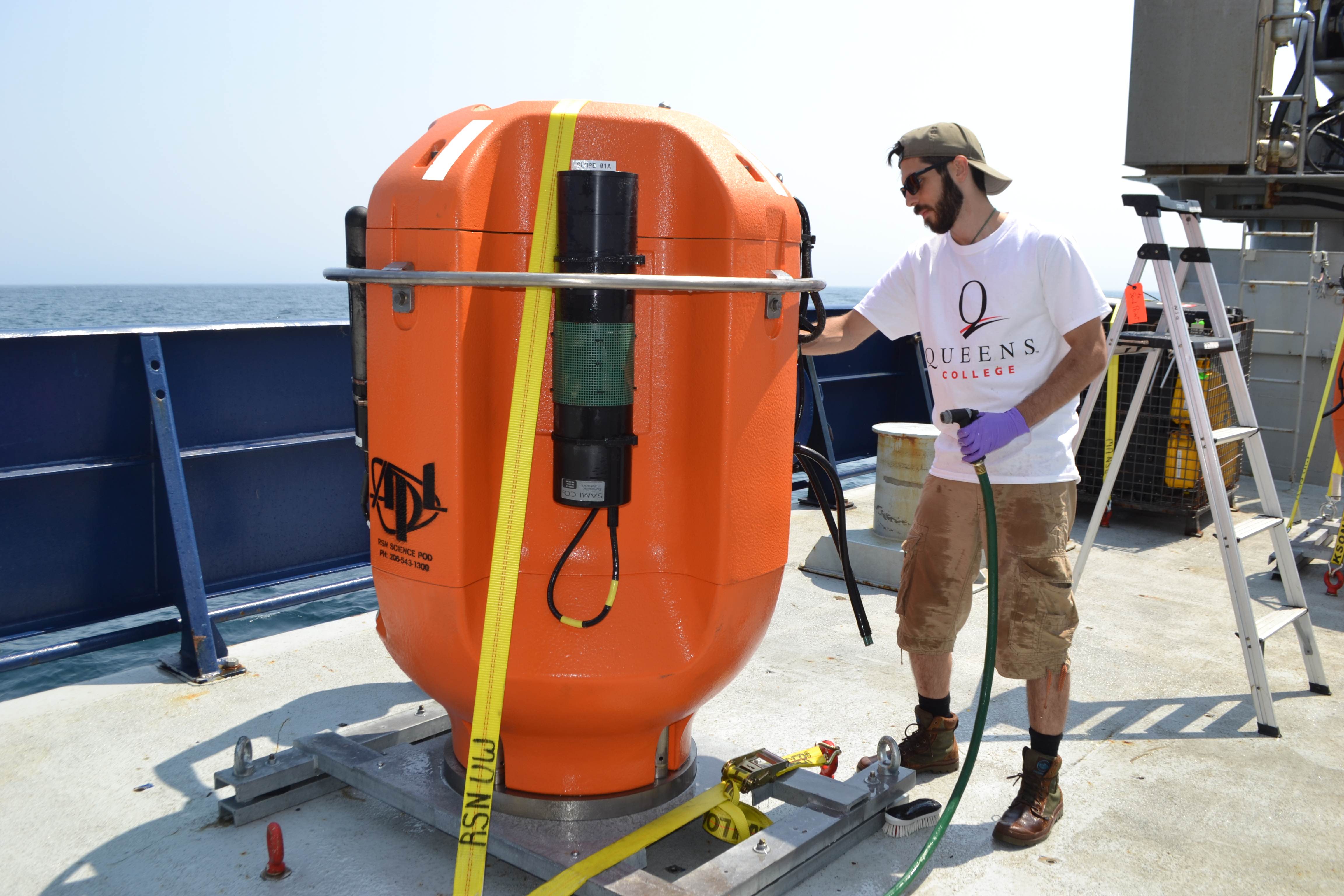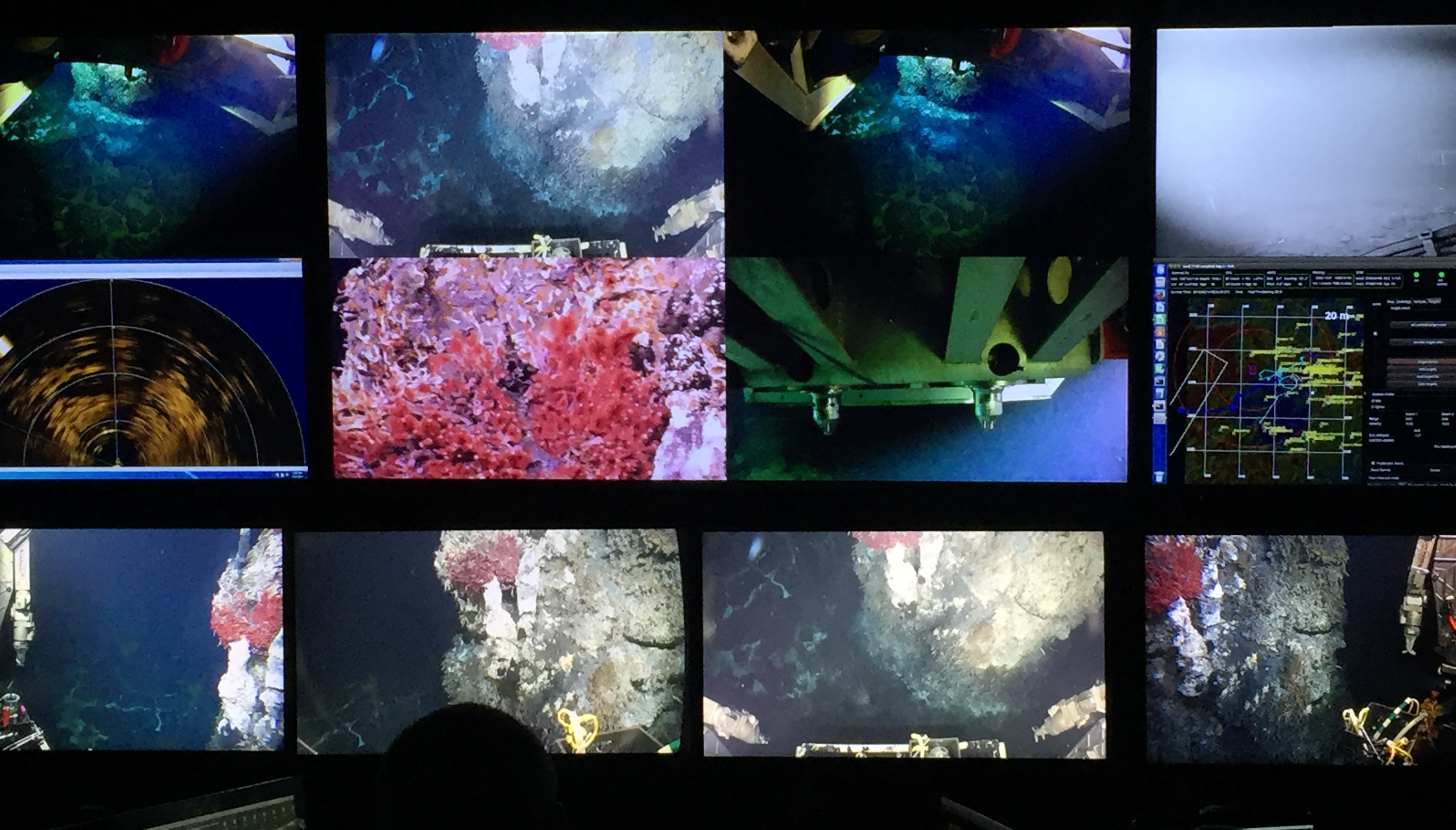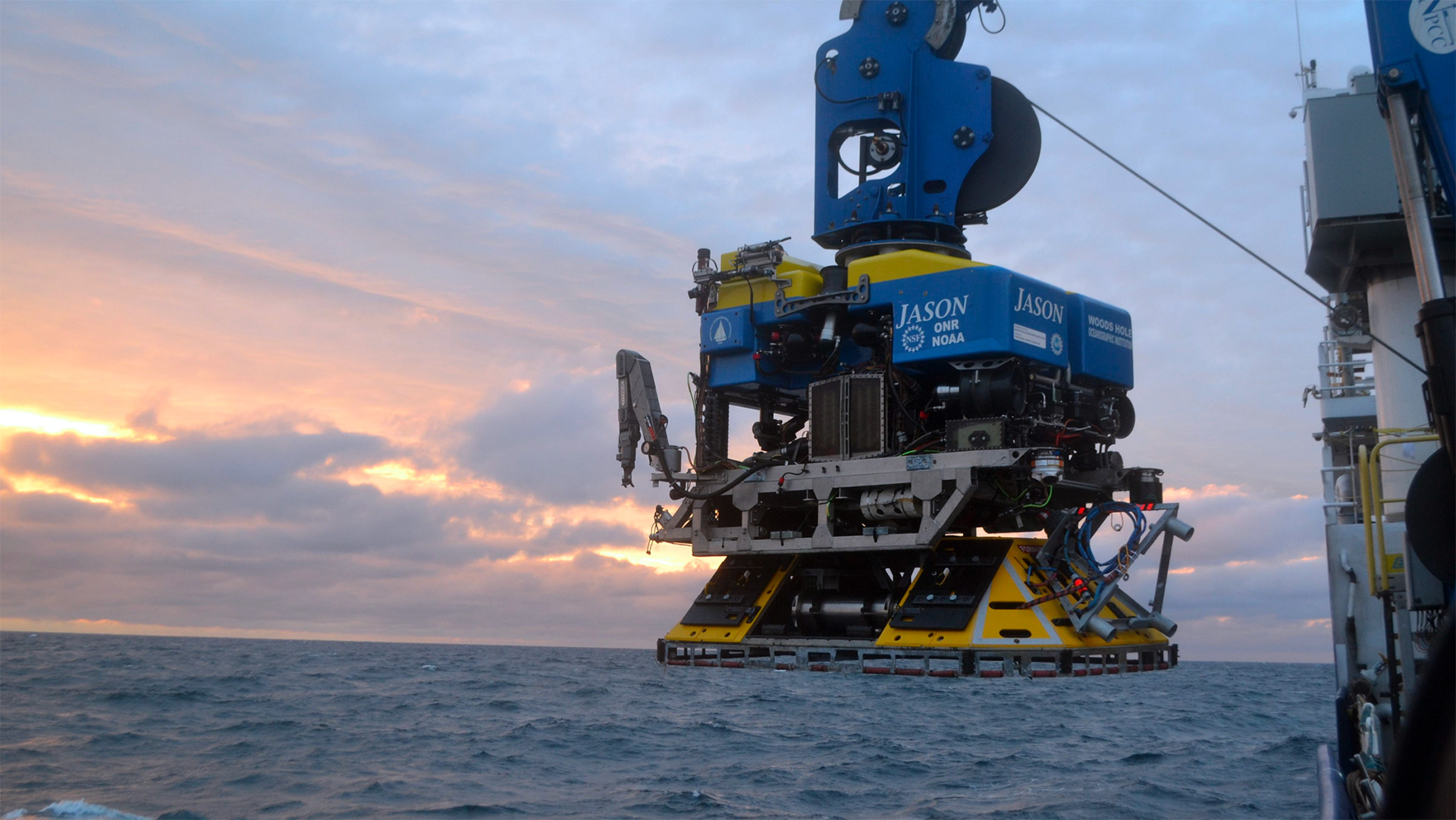Posts Tagged ‘Visions’
RCA Visions 21 Departs for 37-day Expedition
The University of Washington Regional Cabled Array Team left Seattle, Washington on 30 July for its annual Operations and Maintenance (O&M) Expedition for the cabled component of the National Science Foundations’ Ocean Observatories Initiative (OOI), through September 4, 2021. This 37-day cruise is on the global class research ship the R/V Thomas G. Thompson, operated by the University of Washington, which is hosting the remotely operated vehicle (ROV) Jason, operated by Woods Hole Oceanographic Institution.
[media-caption path="https://oceanobservatories.org/wp-content/uploads/2021/07/J1265_20200808_0232_CAMDSB303_recover-copy-2.jpeg" link="#"]ROV Jason breaks the surface above the most active volcano off the WA-OR coast. Credit: UW/NSF-OOI/WHOI. V20.[/media-caption]The expedition can be followed through live video feeds from sea, daily updates, and stunning imagery. During the cruise, virtual visitors will be able to directly observe parts of the seafloor rarely seen by humans – the most active submarine volcano off our coast ‘Axial Seamount’ located about 300 miles offshore and nearly a mile beneath the oceans’ surface. Here virtual visitors can witness one of the most extreme environments on Earth – underwater 700°F hot springs teaming with life that thrives on volcanic gases and lives in the complete darkness of the deep sea. The team will also visit the Cascadia Margin, spending time at Southern Hydrate Ridge where methane ice deposits are exposed on the seafloor with areas of dense microbial mats, and at shallower sites that are some of the most biologically productive areas in the world’s ocean.
[media-caption path="https://oceanobservatories.org/wp-content/uploads/2021/07/overview.flow_.mosquito.sm_.r1772_03229-scaled.jpg" link="#"]A “Mosquito” flow meter (far left) and osmotic fluid sampler (far right) installed on microbial mats Southern Hydrate Ridge. Photo credit: NSF-OOI/UW/CSSF; Dive R1772; V14.[/media-caption]The Regional Cabled Array (RCA) team is excited to get underway and looking forward to being out in the Pacific Ocean again. This is an immense logistics operation with ~ 20 trucks transporting >130,000 lbs of gear to Newport, Oregon in support of highly complex at-sea operations that have required months of planning, and testing of gear to be installed. During the cruise, the ROV will deploy and recover a diverse array of more than 200 instruments, several small seafloor substations that provide power and communications to instruments on the seafloor and on moorings that span depths of 2900 m (9500 ft) to 80 m (260 ft) beneath the oceans’ surface. In addition, several novel, externally funded instruments developed by scientists in the US and Germany will be installed.
This year, the RCA Team will be joined by 19 students sailing as part of the UW’s educational mission (VISIONS’21). The students will be distributed over the four legs of the O&M Expedition. The VISIONS program has allowed >160 students to participate in this at-sea experiential learning program.
Virtual visitors will have the opportunity to share in the students’ wonder and excitement through their blogs and daily updates here. Be sure to bookmark this site and check back often to share in what promises to be a life-changing experience for many students. Share in their adventure!
Article by Deb Kelley, Principal Investigator for the Regional Cabled Array
Read MoreLive Video from Regional Cabled Array Expedition
Don’t miss this rare opportunity to participate in a research cruise from aboard the ship and below the surface. Live video is being broadcast from the Regional Cabled Array’s eighth Operations and Maintenance expedition aboard the R/V Thomas G. Thompson. It is really an extraordinary way to watch first-hand the complexity of the operation involved in keeping a network of 900 kilometers of electro-optical cables supplying unprecedented power, bandwidth (10 Gigabit Ethernet, and two-way communication to scientific sensors on the seafloor and throughout the water column, so data are continuously collected and research conducted. Bookmark these links and tune in often!
Streaming live video from the ship and from the ROV ROPOS.
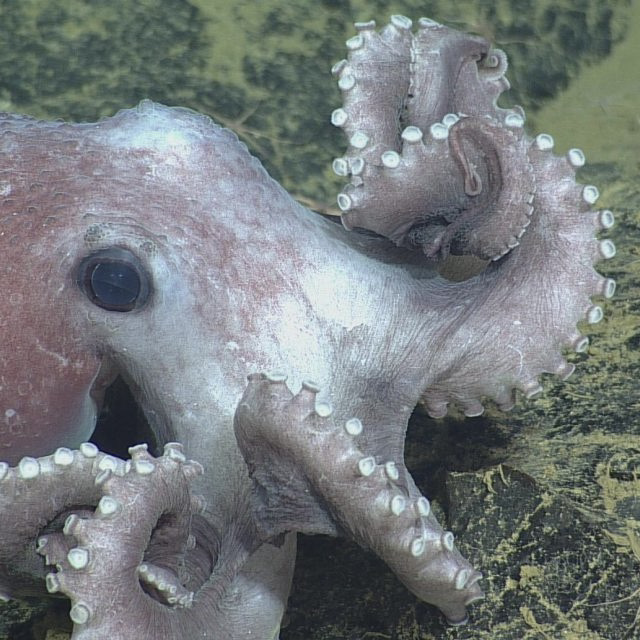 Credit: NSF-OOI/UW/CSSF.[/caption]
Credit: NSF-OOI/UW/CSSF.[/caption]
Read More
Live Video from Regional Cabled Array Expedition
For the month of August, you can be a scientist aboard the R/V Thomas G. Thompson Regional Cabled Array expedition and explore the ocean floor and biologically-rich waters of the northeastern Pacific Ocean in real-time. A livestream is being broadcast of onboard activities and from the ROV, as it recovers and deploys instrumentation to maintain the Regional Cabled Array. Bookmark this livestream link and during August you can experience life and science at sea.
Please note: The livestream video is transmitted from the ship to a satellite, then to shore. Occasionally, the land-based down-link system goes down and depending on the ship’s heading, there may be an intermittent pause in the satellite connection. If the screen is blank or you see an error code, please check back soon as the connection should refresh shortly.
Read More
RCA Embarks on a Month of Discovery in August
The University of Washington (UW) Regional Cabled Array (RCA) team entered a two-week quarantine period on 16 July before heading out to sea August 1, aboard the UW global class research ship the R/V Thomas G. Thompson for a month-long expedition in the northeastern Pacific. The expedition is funded by the National Science Foundation as part of the Ocean Observatories Initiative. The team will need whatever rest they can muster during the quarantine, as the expedition promises to be replete with round-the-clock activity, including multiple dives a day by the remotely operated vehicle (ROV) Jason.
During this expedition, the team will recover and reinstall more than 200 instruments with the ROV, while broadcasting livestream video from the ROV Jason to the ship, to a satellite over 22,000 miles above the Earth. From space, the video will then be transmitted to the UW, where it will be publicly available on the UW InteractiveOceans website. A daily blog will provide updates on the expeditions progress. Throughout the month, viewers will witness life thriving at depths 2900 m (>9500 ft) beneath the ocean surface and at Axial Seamount, the most active submarine volcano off the coast of Oregon and Washington.
[media-caption type="image" path="https://oceanobservatories.org/wp-content/uploads/2020/07/Control-room-_Jason_Hell_-Vent-scaled.jpg" link="#"] An example of some of the stunning imagery that will be live-streamed during the RCA expedition. Credit: Ramya Ravichandran Asha, UW, V19.[/media-caption]The RCA consists of 900 kilometers of cable that provide high-power, bandwidth, and two-way communication to 150 scientific instruments on the seafloor and to state-of-the art instrumented moorings that relay a constant stream of real-time ocean data to shore, 24 hours 365 days a year. All data are freely available to the community.
Being in corrosive saltwater for a 12-month stint is a hostile environment for equipment, so every summer a team of UW scientists and engineers head out to the array to recover equipment and deploy replacement ocean observing instrumentation These recovery and redeployment missions ensure that data continuously flow to shore from this Internet-connected array. At the RCA, cabled instruments are located across the Cascadia Margin, the Southern Hydrate Ridge, and at Axial seamount, each making an important contribution to better understanding the subseafloor environment. Cascadia Margin is one of the most biologically productive areas in the global ocean. Explosions of methane-rich bubbles issuing from beneath the seafloor rise > 1000 feet into the overlying water column at Southern Hydrate Ridge. Axial seamount has erupted in 1998, 2011, and 2015 and hosts some of the most extreme environments on Earth—underwater hot springs venting fluids at >700°C.
Dr. Orest Kawka, an RCA Senior Research Scientist, and Brendan Philip from the UW will sail as Chief Scientists – directing the cruise during the four weeks at sea. As an undergraduate, Philip sailed on numerous RCA cruises as part of the UW educational VISIONS at sea experiential learning program, which has taken over 160 undergraduate students to sea, and later as a member of the RCA team. He is now pursuing a master’s degree in Technology, Science, and Policy at George Washington University in Washington, DC.
Because of the large amount of gear (over 80,000 pounds of equipment) to load onto the fantail of the Thompson for deployment, the cruise will consist of two legs.
[media-caption type="image" path="https://oceanobservatories.org/wp-content/uploads/2020/07/RCA-Jason-manipulator-with-sea-anemones.jpg" link="#"]The manipulator arm of the ROV Jason operates in front of an anemone-covered junction box in the highly productive waters at the Oregon Shelf site. Credit: UW/OOI-NSF/WHOI, V19.[/media-caption]During more than 30 Jason missions to the deep, viewers will witness parts of the ocean rarely seen by humans. The team hopes to revisit some of the scientific highlights of last year’s expedition. One such highlight was Jason being investigated by a swarm of large sable fish. At another site at 80 meters, a junction box became an island completely encrusted in beautiful sea anemones. At Southern Hydrate Ridge, the team saw rarely seen exposed methane hydrate and a moonscape topography dramatically changed from the year before, marked by new explosion pits and collapsed areas. And, on many past expeditions, team members have seen a novel prehistoric-looking fish, which was first filmed in the ocean on the 2014 RCA cruise at the Slope Base site at a depth of 9500 ft. The RCA team fondly refers to this creature as “the weird fish,” (Genioliparis ferox), which also has been documented off Antarctica.
“We’ve got a fantastic team sailing this year, who have been putting in an incredible amount of work for months to get us ready. But like all cruises sailing this year, we’re dealing with the necessary challenge of having a smaller science party and still making sure we can safely accomplish the science and recovery and deployments. We will be in constant communication with the rest of the team back on shore, who will contribute as much to getting our work done as will the science party on the ship. The RCA team is grateful for the opportunity to sail during what has turned out to be a challenging year for ocean science and we’re looking forward to helping other oceanographers continue their research, even if they’re unable to sail this year,” said Chief Scientist Brendan Philip.
[media-caption type="image" path="https://oceanobservatories.org/wp-content/uploads/2020/07/FACT_Cage-scaled.jpg" link="#"]Manipulators on the ROV Jason work on a small frame located ~ 200 m beneath the oceans’s surface, which is encrusted in beautiful feathery creatures called crinoids. Credit: UW/NSF-OOI/WHOI[/media-caption]The Daily Grind
The daily schedule aboard the R/V Thompson promises to be intense, exacerbated by a smaller than normal scientific party due to COVID-19 precautions. “Science teams, when using Jason, tend to keep the vehicle down for a long time, but because the tempo of this cruise is more like an industry cruise, the team will be diving and recovering the vehicle as rapidly as safely possible, sometimes with only a couple hours on deck between dives. It can be exhausting work, particularly for a team that will be onboard for a month,” explained Deb Kelley, RCA Director and principal investigator. “But, being out at sea, seeing the sites and miles of ocean reaching the horizon, and working on this state-of-the-art marine facility makes it all worthwhile.” This year, for the first time, Kelley will be intently observing operations from onshore through the live video stream.
COVID Prevention
A reality in the new COVID-19 world is that the team can only mobilize gear onboard the ship after completing a strict quarantine period. Two weeks prior to boarding, members of the scientific party have lived in their homes (with all family members in quarantine for the duration), hotels or Airbnbs. Team members were tested for COVID prior to entering quarantine and conducted twice day temperature checks during their quarantine. Testing occurred again before being allowed to board the Thompson.
This expedition is novel in another way as a result of COVID precautions. Only two students will be onboard. Prior cruises have had 8-10 VISIONS students on each leg to help out and experience firsthand what it’s like to go to sea. “We are hoping that many students and others tune in to experience this amazing environment that Jason will be revealing over the next month. It’s really an opportunity to visit some of the most extreme environments on Earth and see incredible life forms that has adapted to these harsh environments, which may be particularly uplifting to our spirits now that many folks are stuck at home,” said Kelley.
Livestreaming video will be available here and at InteractiveOceans.
Read MoreAltered Carbon: Improvement to CO2 Measurements Enhance OOI Data Quality
Global carbon dioxide (CO2) concentrations are increasing in the atmosphere, largely due to the use of fossil fuels. The oceans are absorbing about 25-30 percent of the atmospheric CO2, resulting in a shift in seawater acid-base chemistry and a decrease in ocean pH, making seawater more acidic. To help scientists assess this changing ocean chemistry, the Ocean Observatories Initiative (OOI) uses the Sunburst SAMI-CO2 instrument to measure the partial pressure of carbon dioxide (pCO2) from 150-700 microatmospheres (μatm) in the upper 200 meters of the water column.
The distribution of pCO2 in seawater is dependent on gas exchange with the atmosphere at the ocean surface, the breakdown of plant material by microbial processes, and removal by photosynthesis, calcium carbonate formation, and rising temperatures. Increases in pCO2 can also be caused by dissolution of calcium carbonate, which is of particular importance because calcium carbonate minerals are the building blocks for the skeletons and shells of many marine organisms, such as oysters.
Using the SAMI-CO2 instrument, OOI researchers determine the partial pressure of CO2 by equilibrating a pH sensitive indicator solution (Bromothymol Blue) to sampled seawater. Aqueous carbon dioxide in seawater diffuses across a permeable silicone membrane equilibrator within the instrument, which changes the color of the indicator solution from blue to yellow. The equilibrated indicator solution is then pumped through a chamber where light passes through the liquid and into a receptor that uses the wavelength to determine the amount of color change, and thus the amount of CO2 dissolved in the water.
“The OOI system parses the raw data from the instrument, applies a ‘blank’ value to correct for instrument drift, and then delivers calibrated pCO2 data to users on demand,” explained Michael Vardaro, OOI Research Scientist at the University of Washington. “We recently created a fix to apply the correct ’blank’ values to the pCO2 data to improve data accessibility and data quality.”
Blank values (e.g., optical absorbance ratios in the pco2w_b_sami_data_record_cal data stream) are used to calculate the data product “pCO2 Seawater (µatm)” at a specific timestamp. Blank values, however, are recorded intermittently to correct for drift of the electro-optical system, about once a week, which is a longer interval than the instrument sampling rate of one sample per hour.
The recent correction will ensure that any pCO2 data request will use a linearly interpolated value from the closest blanks if no blank value is found within the requested time range. This means that for an hourly pCO2 measurement that falls between weekly blank values the system will calculate the appropriate drift correction to apply based on the surrounding blank values, instead of trying to find a specific blank value that might be outside the date range of the requested data. In addition to improving data quality, this fix prevents the system from returning fill values or empty datasets. Additional restrictions were put on data delivery to prevent interpolation across deployments, which could pull blanks from different instrument serial numbers, potentially creating bad data. These fixes apply to all OOI pCO2 data. Users who have pCO2 data products generated prior to 4 February 2020 are encouraged to re-request their data to ensure that the correct interpolation code is applied.
Any questions about this data fix, or any other OOI data issues, should be directed to help@oceanobservatories.org.
Images
Top: Alex Andronikides, a VISIONS’17 student from Queens College, New York helps clean a Regional Cabled Observatory Shallow Profiler Mooring science pod that was installed off the Washington-Oregon coast. Credit: M. Elend, University of Washington, V17.
Bottom: Pre-deployment photo of a Sunburst SAMI-CO2 sensor attached to the Oregon Offshore Cabled Shallow Profiler pod, which moves up and down in the water column between 200 meters and near the surface off the coast of Newport, OR. Credit: M. Elend, University of Washington, V19.
Read MoreRegional Cabled Array 2019 Expedition Sets Records
This summer’s Regional Cabled Array (RCA) 44-day expedition (May 30-July 12, 2019) onboard the R/V Atlantis was highly successful with the completion of all tasks scheduled for this annual maintenance and operations cruise. One hundred forty-nine out of 151 RCA Core and PI instruments are operational, all three instrumented Deep Profiler vehicles and instrumented Science Pods on the Shallow Profiler Moorings are conducting daily traverses through the water column, and 113 RCA instruments were installed. It was wonderful to once again see the beautiful life inhabiting the hydrothermal vents at Axial Seamount, amazing aggregations of cod curious about our work at the Oregon Offshore site, and to witness the profound changes that have taken place again at the methane seeps at Southern Hydrate Ridge.
During the 53 days of staging and demobing for the cruise over the four legs 166 tons of RCA equipment were transported to/from Seattle, WA and Newport, OR. Onboard staffing included 52 personnel with 13 students, six non-OOI PI’s-technicians from four institutions and one member from industry. In addition, Susan Casey, a New York Times bestselling author (i.e. The WAVE, the Devils Teeth, and Voices of the Ocean) participated on Leg 4. As part of the NSF Oceans Month, a 1-hour “Science in the Deep” Facebook live interactive broadcast was conducted, including live streaming of imagery from Jason working at Southern Hydrate Ridge and a period for questions and answers. There were 58 Jason Dives, with a record setting 20 dives in five days including deep dives to 2600 m and 2900 m water depths. The vehicle worked extremely well with turn-arounds commonly less than one hour.
Another big success for this summer occurred during nine days of at-sea operations dedicated to turning and installation of cabled and uncabled instrumentation and field work provided to externally-funded researchers. This work included the:
- Installation of an NSF-funded new high resolution, self-calibrating pressures sensor at Central Caldera, Axial Seamount (W. Wilcock, University of Washington).
- The recovery, repair and reinstallation of the NSF-funded COVIS multibeam sonar for hydrothermal plume imaging at the ASHES hydrothermal field, as well as installation of a thermistor array (K. Bemis, Rutgers University); Bemis also conducted a several hour thermal and video survey of the field.
- The turning of an NSF-funded CTD at the ASHES hydrothermal field, Axial Seamount (W. Chadwick, Oregon State University). Note Chadwick received a new NSF award to expand the CTD network to monitor the release of subsurface brines associated with eruptions at Axial as observed during the 2015 eruption (see Xu et al., 2018).
- The recovery of an ONR-funded uncabled Benthic Observatory Platform (BOP) from the Oregon Offshore site and installation of another BOP at a seep site at Southern Hydrate Ridge (C. Reimers-Oregon State University and P. Girguis-Harvard University) and associated sediment sampling; and
- The recovery, repair, and reinstallation of a University of Bremen-Germany-funded cabled overview multibeam sonar for imaging of all methane plumes at Southern Hydrate Ridge (G. Bohrmann and Y. Marcon -University of Bremen) – the range of this sonar is now extended from 200 m to 700 m. A new 4K video-still camera was also installed near Einsteins’ Grotto.
The RCA engineering and science team is enjoying being on land after conducting round the clock operations to insure that the facility work was completed on schedule. Folks are enjoying the Seattle sun and the Cascades and Olympic mountains during the summer blue-skied days. Soon however, our thoughts, will be turning to refurbishment and planning for next years cruise. The team is looking forward to working with the VISIONS19 students on their projects this upcoming academic year; we are excited to see the stories they tell with new eyes focusing on the oceans, the RCA, and OOI.
Read MoreStreaming Live From the Deep: The 2019 OOI Regional Cabled Array expedition
This summer’s exciting sea-going expedition in the Northeast Pacific to maintain the National Science Foundation’s Ocean Observatories Initiative Regional Cabled Observatory is underway, and you can join us at InteractiveOceans.
Over the next several weeks, the University of Washington Cabled Array team will be adding novel sensors that allow a global audience to watch live the daily deformation and seismic activity at the largest underwater volcano off our coast, Axial Seamount. Axial erupted in 2015 and is poised to do so again. In addition, we will be adding new instruments, including a 4K video camera aimed at a highly dynamic methane seep site off Newport, Oregon, called Southern Hydrate Ridge, where streams of bubbles issue from the seafloor daily.
[media-caption type="image" path="https://oceanobservatories.org/wp-content/uploads/2019/06/AtlantisBackdeck_1_small-1080.jpg" link="#"]R/V Atlantis steams back to shore after Leg 1 of the 2019 Regional Cabled Array cruise, following the successful installation of the Shallow Profiler Mooring at Axial Base. Photo by J. Tilley, University of Washington[/media-caption]The cruise, which departed June 2 and continues until July 12, is using the remotely operated vehicle (ROV) Jason onboard the R/V Atlantis operated by Woods Hole Oceanographic Institution. Nineteen U.S. and international undergraduate students are working side-by-side scientists, engineers, ROV team, and ship’s crew on the expedition as part of the UW experiential at-sea VISIONS program.
This expedition is highly complex with a diverse array of more than100 instruments, junction boxes, and instrumented pods on the Shallow Profiler Moorings that will be recovered, installed, and tested. R/V Atlantis will be “packed to the gills” on each of the four legs that make up this expedition, carrying everything from state-of-the-art mooring components to sharpies.
Starting around June 12 or 13, you will be able to watch our underwater operations live through streaming video as ROV Jason works more than 300 miles offshore and 5,000 feet below the surface down at the summit of Axial Seamount, which hosts 350°C (660°F) deep-sea hot springs that support some of the most bizarre creatures on Earth. We will also be 250 miles off Newport in depths ranging from 250 feet to 10,000 feet in some of the most biologically productive waters in the world and at sedimented sites on the Cascadia margin where methane-rich plumes jet from the seafloor. There, methane seeps support dense bacterial mats and large clams that thrive in the absence of sunlight on gases pouring from the seafloor.
A 4K camera funded by the University of Bremen will provide real-time views of the methane plumes and seafloor life to document this incredibly dynamic environment marked by large explosion pits and collapse basins. This is the second year of this international collaboration that expands the capability of the Regional Cabled Array and provides new imagery of these dynamic systems for all to see.
An enhanced, high-bandwidth satellite connection from R/V Atlantis will allow you to experience our deep-sea operations through daily live video streams. It will also allow onboard engineers and scientists to see data for the first time as new instruments are connected to the seafloor submarine fiber optic cables that bring the global Internet into the oceans. So tune in and see what we see when we see it.
Read More
